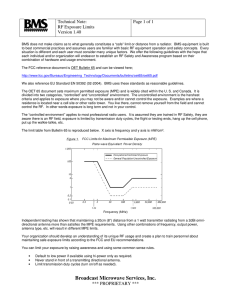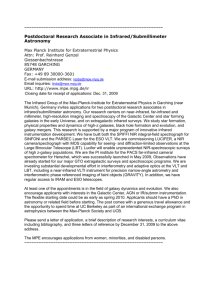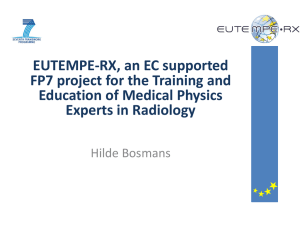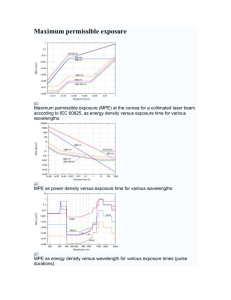Practical Application of Suspension Criteria Scenarios: General
advertisement
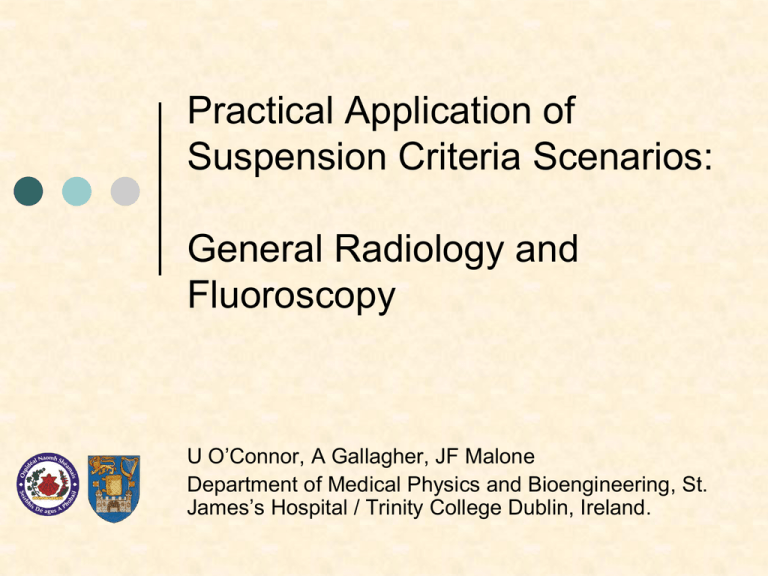
Practical Application of Suspension Criteria Scenarios: General Radiology and Fluoroscopy U O’Connor, A Gallagher, JF Malone Department of Medical Physics and Bioengineering, St. James’s Hospital / Trinity College Dublin, Ireland. Introduction Revised EC RP-162 specifies minimum standards Criteria of Acceptability / Suspension Levels Radiology equipment should be assessed against these standards prior to its first clinical use and regularly throughout its lifetime. Equipment that does not meet the criteria must be removed from use… however… Role of the MPE May be possible to return equipment to some limited form of use based on risk assessment by Medical Physics Expert (MPE) in conjunction with practitioner Decisions to suspend equipment will clearly have consequences for patient access. May place a financial burden on the institution in terms of equipment repair or replacement. Equipment assessed against criteria of acceptability Pass Equipment returned to clinical use Fail Limit on Use Risk Assessment by MPE / RPA Fail Repair or replace Written recommendation to suspend equipment Practitioner “Half of 13 new systems that were being commissioned were defective” Age is just a number… …. Just another factor in your decision-making Overview of Authors Medical Physics & Bioengineering Dept., St. James’s Hospital responsible for commissioning, QA & radiation advice asset base >100 general X-ray and fluoroscopy systems Typical arrangement (in Ireland) assessment carried out by MPE / Radiation Protection Adviser (RPA) or delegate decisions signed off by the RPA MPE role becoming established. Many functioning as MPE. RPA register well established - formally appointed named person. Case 1: General Radiology Radiographer’s QC testing of General radiology system at busy regional hospital Film/screen image receptor Non-uniform optical density on all films taken with vertical bucky. Noticeable on clinical images. Radiographer contacted MPE for advice. Not evident at previous QA (<3 months) Case 1: General Radiology Results exceeded the suspension level from RP-162 Also exceeded levels from RP-91 (1997) Parameter Suspension level Film-Screen contact Non-uniform density or loss of sharpness Visual Check of Uniformity Artefacts apparent Case 1: Risk Assessment MPE liaised with Radiologist who agreed that non-uniformity was affecting clinical image quality. Equipment suppliers: Issue could not be rectified due to age (25 yrs) of equipment and lack of spare parts. Other considerations no AEC – not on a par with modern systems equipment replacement programme advised previously in QA reports. RPA made recommendation (in writing) to the holder Equipment must be replaced immediately. Case 1: Limits on Use Pending replacement of the equipment, Consultant Radiologist had to advise on scope of practice if vertical bucky was required clinically. E.g. Radiologist may consider small field extremity images to be acceptable if non-uniformity across width of bucky is not clinically significant. Case 2: Mobile Radiography Annual QA testing of General radiology mobile CR image receptor MPE identified significant cut-off when measuring the X-ray field to light field alignment. Results exceeded suspension level from RP-162 & RP-91 Parameter X-ray / light beam alignment Setup 1m SID 7cm x 9cm Result 6% or 6cm Suspension level Misalignment in principle directions > 3% of focusimage receptor distance (SID) Case 2: Risk Assessment Equipment suppliers: X-ray tube insert had moved in cathode direction within tube housing. Result was image cut-off on anode side of X-ray system. MPE carried out a risk assessment on the unit Taking into consideration no other mobile X-ray system in the Hospital mobile required for emergency and ICU exposures workload is low & new mobile due in 2 weeks time cut-off was less pronounced at clinical setup Case 2: Limits on Use RPA advised that mobile X-ray system may be used in limited circumstances until delivery of new unit in 14 days. only where absolutely necessary and at SID of at least 1.8m. Also advised that alignment must be checked by radiography staff on a daily basis to monitor for deterioration Greater potential for further damage on mechanical movement Case 3: DDR AEC Commissioning of two new General Radiology systems DDR detectors - identical systems from same supplier State-of-the-art installations into new Radiology department at large Irish hospital. IPEM ASM, 2008 Case 3: DDR AEC Dose to detector in AEC mode for both systems was measured to be 38 - 50µGy. ~900% greater than that achieved on other DR systems. System had been released by suppliers having passed their recommended tests. “In the absence of tolerances… significant time liaising with suppliers to rectify the problems”. Case 3: Risk Assessment System would pass RP-91 and IPEM but fail RP-162 MPE made a judgement on detector dose based on local database from other DR systems. Equipment engineers adjusted the dose following intense consultation with MPE supplier relying on factory settings with little consideration for clinical setup lack of understanding regarding what MPE was trying to achieve. Following adjustment and retest by MPE, detector dose still remained higher than acceptable. Case 3: Outcome Further adjustment by service engineers. Dose and image quality found to be acceptable. Very interesting case which shows difficulty in assessing new technology for which there is little established criteria. Similar cases have occurred elsewhere with similar difficulties and outcomes. Highlights problem with establishing a reasonable baseline value at commissioning and relying on that value for future testing. Equipment supplier-specific training on requirements stemming from criteria of acceptability would be of benefit. Image Wisely - Image Gently Case 4: Fluoroscopy Annual QA testing of Fluoroscopy system. II-TV system 8 years old Parameter Setup Result Suspension level Air Kerma Rate at Image Receptor 1mm Cu FF Grid Out 2.6μGy/s >1μGy/s Patient Entrance Kerma Rate 20cm PMMA FF Grid In 18.4mGy/min - more than doubled since previous QA 100mGy/min (RP-91*) 75mGy/min (draft RP-162*) * 25cm phantom Case 4: Image Quality Overall image quality was poor Failed to meet the criteria recommended in RP91, IPEM and draft RP-162 Parameter Setup Result Suspension level Threshold Contrast Leeds N3 FF 5.5% >4% for 3mm targets Leeds Test Objects N3 – Example of Good Low Contrast Resolution Case 4: Risk Assessment Service engineers were contacted as they had just completed a routine service. They noted that there were problems with the system which were not yet resolved. Highlights importance of communication between service engineers, radiographers and physicists Benefit from using a handover sheet post-service UK MEDICAL-PHYSICS-ENGINEERING Mailbase July 2011 Case 4: Outcome Image quality issues combined with obvious system degradation. Highlights importance of system performance tests such as air-kerma at II entrance. MPE advised that system should not be used until problems addressed. Verbal advice given on day of QA testing following consultation with RPA. Written memo sent to hospital management, consultant radiologist and radiographer in charge. Case 4: Outcome Limits on Use: Workload / clinical considerations System could be operated in radiographic mode if required. Large regional hospital with a second fluoroscopy system available. Hospital acknowledged the problems with system and it was replaced. Discussion Application of suspension criteria in busy diagnostic imaging facilities requires careful judgement Decisions to remove equipment from clinical use are not taken lightly. In all cases presented here, the MPE carried out a risk assessment based on equipment faults information from supplier advice from RPA and input from radiology staff on clinical needs Where possible, the MPE will advise on continued use of equipment in limited circumstances. Note on Scope of RP-162 Authors have experienced numerous other issues which have resulted in suspension of radiology equipment. Mainly related to electrical safety, room shielding and equipment design issues. Outside scope of report RP-162 However form an important part of the overall assessment of a diagnostic imaging facility. Conclusion Scenarios presented here show the challenges involved in decision-making on radiological equipment. New report EC RP-162 aids the decision-making process by expanding on EC RP-91 report (1997) to include advice on CR / DDR additional criteria for existing technology such as fluoroscopy. guidelines for new technologies for which criteria are not defined and for implementation of suspension procedures Practical Application of Suspension Criteria Scenarios: General Radiology and Fluoroscopy U O’Connor, A Gallagher, JF Malone Department of Medical Physics and Bioengineering, St. James’s Hospital / Trinity College Dublin, Ireland.


